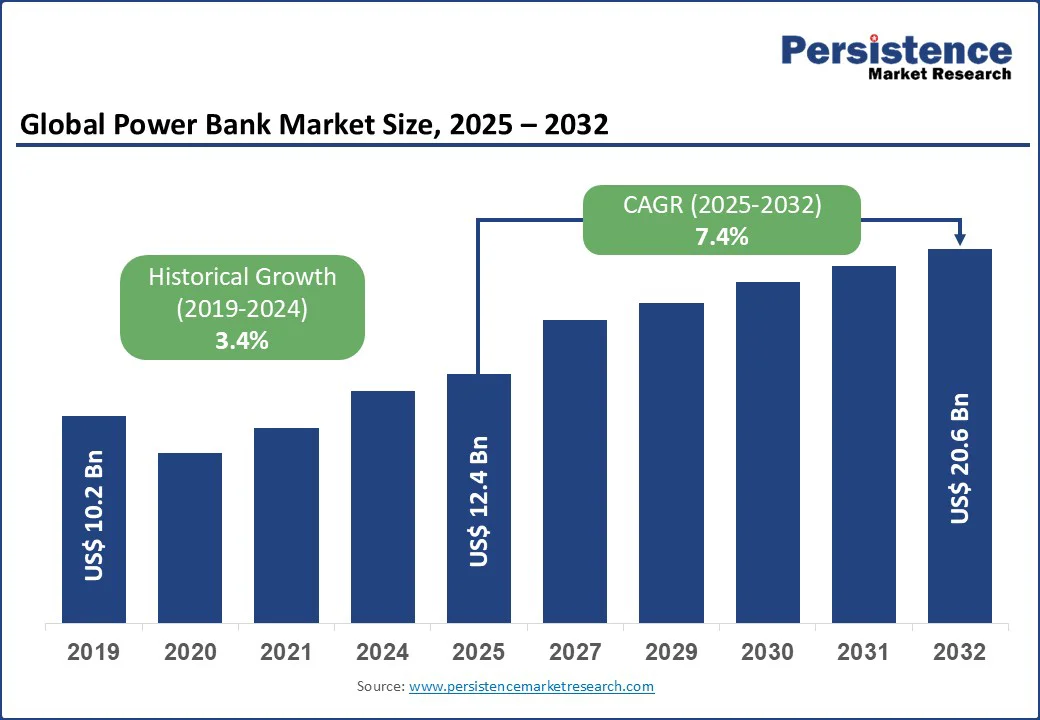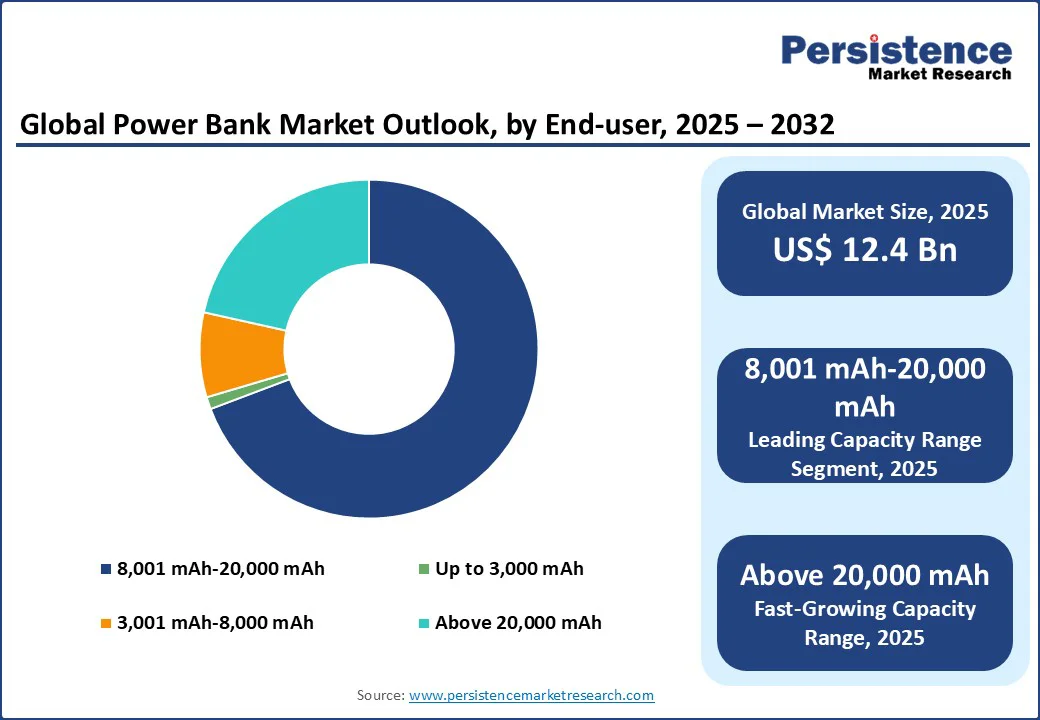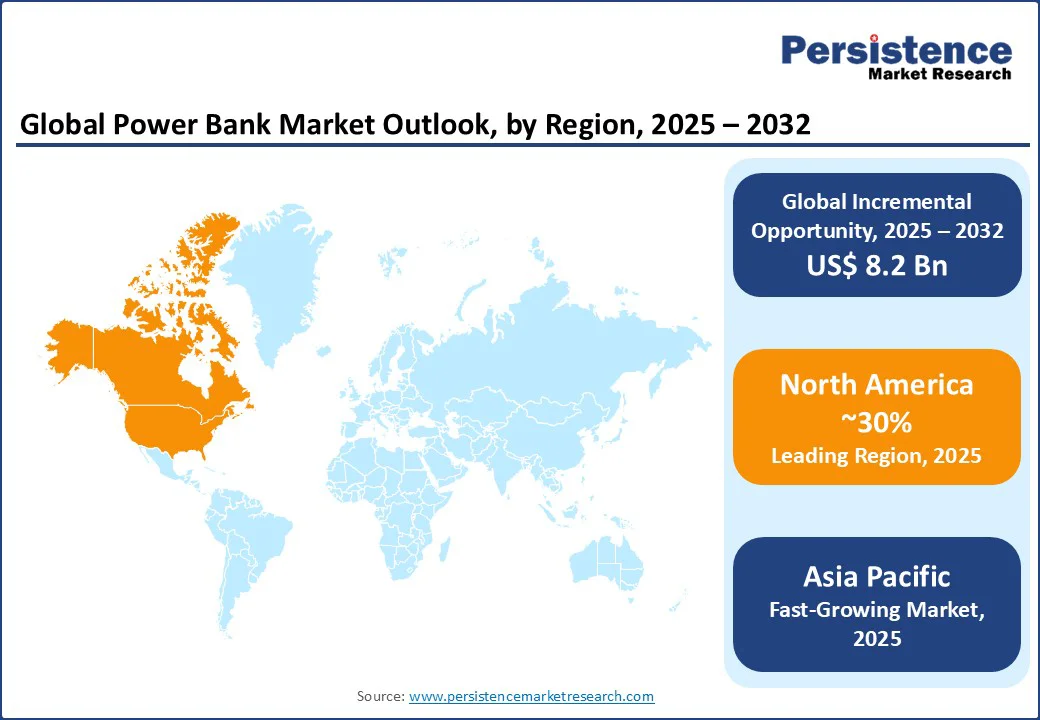ID: PMRREP33479| 198 Pages | 26 Aug 2025 | Format: PDF, Excel, PPT* | Energy & Utilities

The global power bank market size is likely to be valued at US$12.4 Bn in 2025 and is expected to reach US$20.6 Bn by 2032, growing at a robust CAGR of 7.4% during the forecast period 2025 - 2032.
The growth is advancing with multi-functional, wireless models such as Ambrane’s AeroSync Quad and Xiaomi’s Power Bank Lite Set. Qi2-certified wireless charging, showcased by Anker’s MagGo Qi2 Slim 5K, is driving faster, cable-free convenience, catering to the end-user needs.
The global power bank market is rapidly growing as smartphones and mobile devices become integral to daily life. For corporate professionals, reliable power banks ensure uninterrupted connectivity during meetings and travel. Travelers benefit from portable chargers that keep devices powered in remote locations without access to outlets. Avid readers using e-readers and tablets rely on power banks for extended reading sessions on the go.
With over 80% global smartphone ownership, the demand for high-capacity, fast-charging power banks has surged. Brands such as Anker and Xiaomi offer models exceeding 20,000mAh, capable of multiple device charges, meeting diverse needs from business trips to outdoor adventures. As mobility and digital dependency increase, power banks have become essential tools, enabling continuous productivity, entertainment, and communication anytime, anywhere.
Key Industry Highlights:

Rapid growth in the number of smartphone users globally, coupled with a significant increase in screen time, has become a critical driver for the power bank market. For instance, the global number of smartphone users has surpassed 6.8 billion in 2024, representing around 85% of the worldwide population.
The widespread adoption has been further amplified by the surge in affordable devices and increased internet penetration. It is especially evident in emerging economies such as India, Brazil, and Southeast Asia.
Smartphones are becoming essential tools for communication, entertainment, education, and remote work. Hence, users now spend an average of 4 to 6 hours daily on their devices. This includes 2 hours and 23 minutes scrolling through social media, one hour and 25 minutes streaming music, and 49 minutes listening to podcasts.
Notably, most of this screen time, i.e., 3 hours and 50 minutes, is spent using mobile devices. This rising reliance has led to increasing concerns over battery life, creating a robust demand for power banks as a reliable solution to sustain device functionality throughout the day.
Wireless charging power banks offer convenience but face criticism for lower energy efficiency compared to wired models, with up to 30% energy loss during transmission, according to the U.S. Department of Energy. This inefficiency increases electricity consumption and greenhouse gas emissions, raising environmental concerns.
For consumers, less efficient systems lead to high electricity bills, while the added energy demand strains power grids and increases reliance on non-renewable energy, exacerbating climate change. As sustainability becomes a priority, these inefficiencies face growing scrutiny, particularly among eco-conscious individuals. To address this, manufacturers are working to improve efficiency through developments like resonant charging systems that reduce energy loss. However, high development costs and infrastructure needs may delay widespread adoption.
Rapid adoption of wearable devices and IoT applications presents a significant growth opportunity for the global power banks industry. Wearables such as fitness trackers, smartwatches, and health monitors rely on battery power, but their compact size limits battery capacity, driving demand for portable charging solutions. Similarly, IoT devices such as smart home gadgets and outdoor sensors often require periodic charging, especially in remote areas where traditional power sources are unavailable.
Power banks provide a practical solution for these devices, particularly in scenarios such as camping, travel, or fieldwork. Specialized power banks with features like wireless charging, multi-device compatibility, and fast-charging capabilities are increasingly appealing. Novel models with USB Type-C ports and AI-powered power management enhance charging efficiency, further boosting their utility.
As wearables and IoT devices continue to surge in functionality and usage, demand for portable power solutions is anticipated to rise significantly. It is estimated to help solidify power banks as essential accessories for consumers and businesses alike.
Power banks in the 8,001-20,000 mAh range dominate the global scenario, accounting for an estimated 69% share by 2025. Their popularity stems from a strong balance of portability, affordability, and multi-device charging capability, making them ideal for students, professionals, and frequent travelers. Integration of fast charging and multiple ports further enhances their appeal, ensuring consistent demand across consumer groups.
High-capacity models (above 20,000 mAh) are witnessing steady adoption among heavy users of laptops, gaming devices, and multiple smartphones. Backed by advanced features such as Power Delivery and high-wattage fast charging, these devices are positioned as premium solutions for extended power backup.
Recent launches by Anker (25,000mAh, 165W), Xiaomi (20,000mAh Power Bank 4i), and Samsung (20,000mAh, 45W) highlight strong innovation in this category. The above 20,000 mAh segment is projected to expand at a CAGR of 6.4% through 2032, reflecting consumer demand for performance-driven charging solutions.
Introducing a solar power bank in the low-price segment offers a valuable opportunity for the global power banks industry. As demand for renewable and affordable charging solutions grows, solar-powered power banks cater to these needs by providing a renewable, off-the-grid power source.
The devices are particularly appealing in regions with limited access to electricity, such as parts of Southeast Asia, Sub-Saharan Africa, and Latin America, where power outages or lack of infrastructure make conventional charging methods difficult. A solar power bank can serve as a reliable alternative for charging mobile devices in remote areas.
Rising penetration of smartphones in emerging markets further amplifies the need for affordable and sustainable charging solutions. As the price of solar panels continues to decrease, the cost of manufacturing solar power banks has become more affordable, allowing companies to introduce these products at lower price points. This trend makes solar power banks accessible to budget-conscious consumers, especially in developing regions where affordable power banks are in high demand.

North America dominates the power bank market due to high smartphone penetration and substantial smartphone shipments. With a penetration rate of around 89%, the U.S. leads globally in smartphone adoption, reflecting a tech-savvy consumer base that relies heavily on portable devices. This high usage creates a strong demand for supplementary charging solutions like power banks to ensure uninterrupted connectivity.
In 2023, the U.S. recorded about 130 million units of smartphone shipments, which is about 38% of the country’s total population. The unique retail infrastructure in North America, coupled with the widespread availability of premium power bank brands, boosts sales in the region, accounting for about 26% of the market share in 2025.
In addition, a significant portion of the population in North America is inclined toward outdoor activities, travel, and hybrid-work models, which amplifies the need for portable power solutions. This amplifies its market position as an eminent market for power banks.
Consumer demand in Europe is being driven by high smartphone penetration and the widespread use of portable devices, pushing interest in power banks with fast charging, eco-friendly materials, and wireless capabilities. On the supply side, manufacturers are innovating with graphene batteries, higher energy density, and sustainable options such as solar-powered models.
Europe holds over 23% of global revenue in the wireless power bank segment, which is projected to grow at a 7.4% CAGR through 2032. Regulatory frameworks and environmental considerations, particularly around lithium-ion battery production and disposal, also shape the market, compelling manufacturers to adapt to evolving European safety and sustainability standards.
Asia Pacific remains the fastest-growing market for power banks, supported by widespread smartphone adoption and the region’s large young population. Countries such as China, India, and Southeast Asian nations are witnessing strong uptake, driven by rising internet penetration and the increasing need for affordable charging solutions.
The region also shows a clear preference for mid-range capacities (8,001-20,000 mAh), which balance portability and multi-device charging, making them the most popular among mainstream users. Wireless charging power banks are also gaining momentum, with Asia Pacific accounting for around 30% of global revenue in 2025, reflecting the region’s shift toward advanced charging technologies.

The global power bank market is dominated by several China-based players due to technological and raw material advantages in the manufacturing of cheap and high-performance power banks. However, key players from emerging markets are posing tough competition with their low-price product segments.
The power bank industry is classified as fragmented, with the presence of several market participants. However, the top players account for one-fifth of the market share. New players are focusing on creating environmentally friendly batteries from recycled materials.
Key brands in the portable power solutions domain are increasingly focusing on high-capacity, fast-charging, and wireless power banks, which are gaining strong traction among tech-savvy consumers. The integration of advanced technologies such as USB-C Power Delivery (PD) and Qualcomm® Quick Charge has enhanced charging speed and efficiency, while continuous product launches with improved designs and energy performance reflect the industry’s emphasis on innovation.
The Power Bank market size is estimated to be valued at US$ 12.4 Bn in 2025.
"Surging reliance on power-backed devices, such as smartphones, laptops, and tablets" is the key demand driver for Power Bank market
In 2025, North America region dominates the market with ~26% share in the global Power Bank market.
Among energy source, demand for solar powered power bank is expected to grow rapidly at 17.1% CAGR from 2025 - 2032.
Anker Technology Co. Ltd., Xiaomi Corporation, Samsung SDI Co., Ltd., RAVPower (by Sunvalley), AUKEY, and Ambrane India Private Ltd. are the leading players in power bank market.
|
Market Attributes |
Key Insights |
|
Power Bank Market Size (2025E) |
US$ 12.4 Bn |
|
Projected Market Value (2032F) |
US$ 20.6 Bn |
|
Global Market Growth Rate (CAGR 2025 to 2032) |
7.4% |
|
Historical Market Growth Rate (CAGR 2019 to 2024) |
3.9% |
|
Forecast Period |
2025 to 2032 |
|
Historical Data Available for |
2019 to 2023 |
|
Market Analysis |
|
|
Key Regions Covered |
|
|
Key Market Segments Covered |
|
|
Key Companies Profiled in the Report |
|
|
Report Coverage |
|
|
Customization and Pricing |
Available upon request |
By Capacity Range
By Energy Source
By Battery Type
By Distribution Channel
By Region
Delivery Timelines
For more information on this report and its delivery timelines please get in touch with our sales team.
About Author